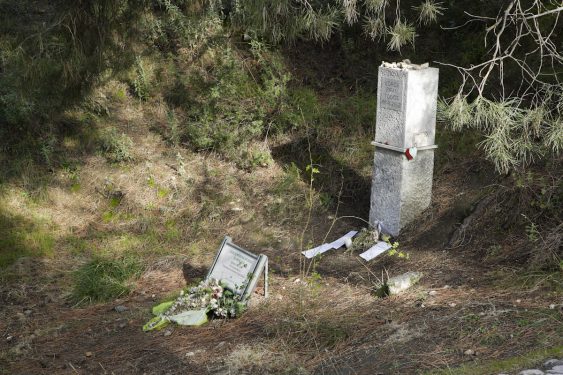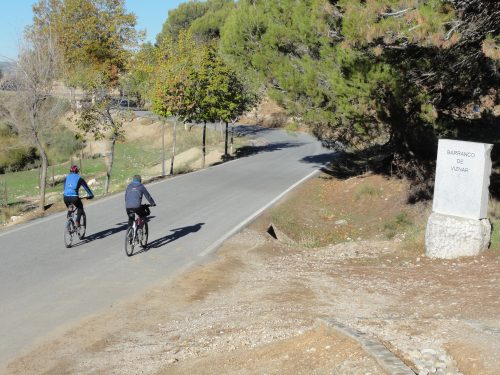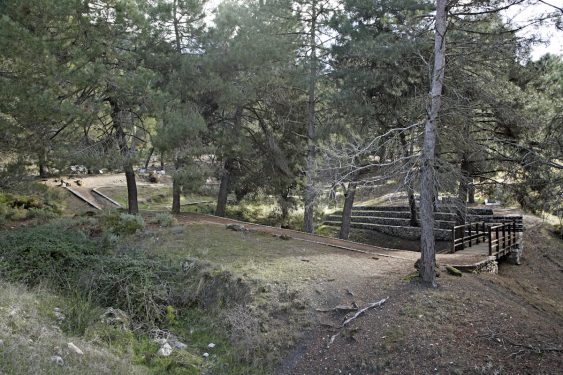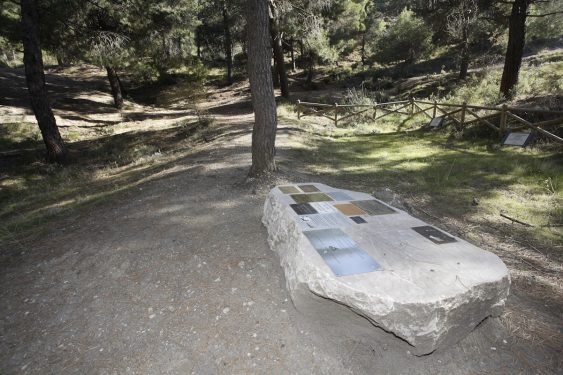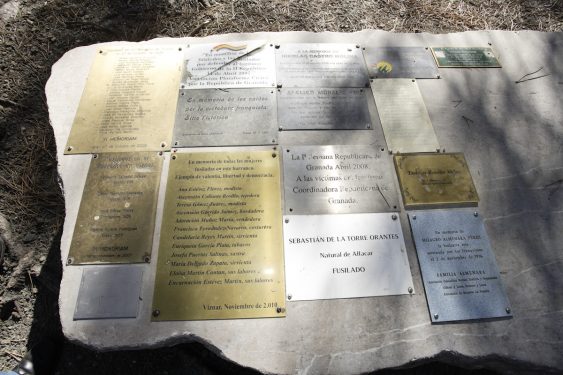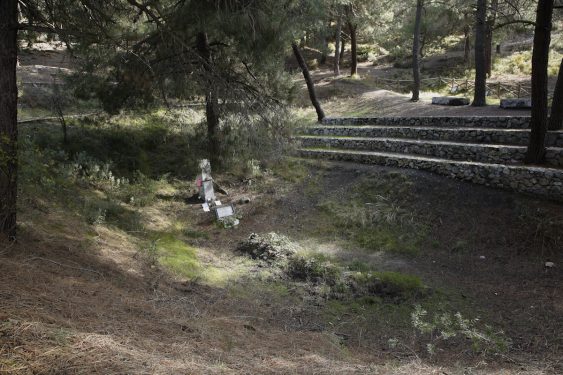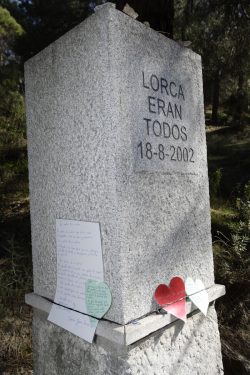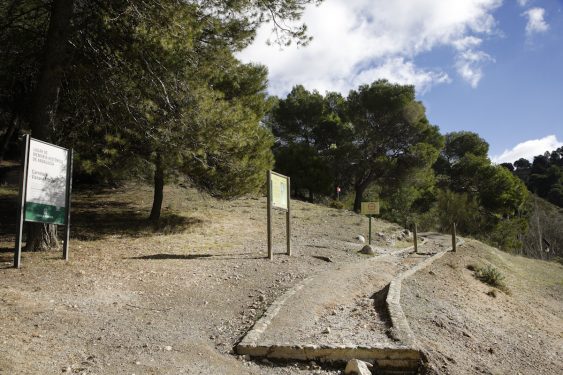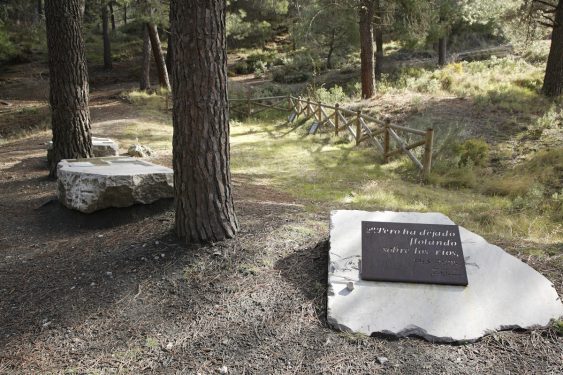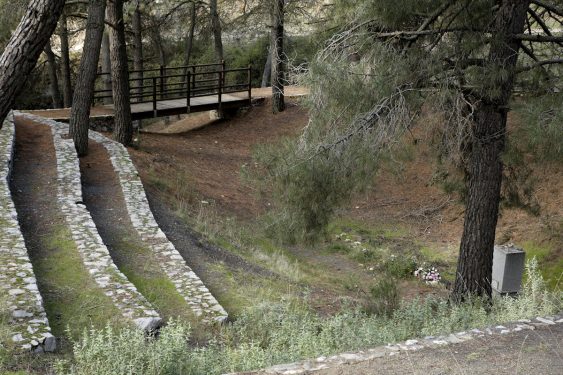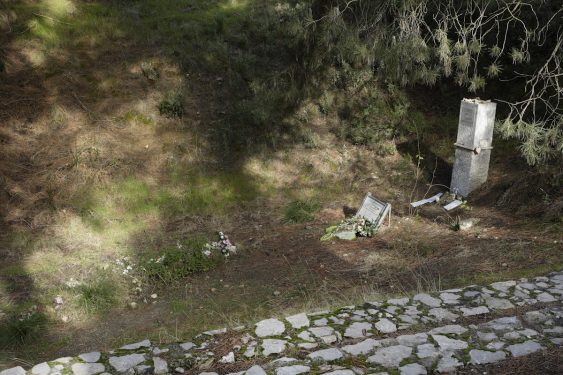It is a sloping area, declared a place of Memory, where hundreds of victims of Franco’s repression were shot and buried in mass graves.
Barranco de Víznar (Víznar Ravine) is a sloping edge of about 10,000 square meters that descends on a sharp and shady curve of the road between Alfacar and Víznar, declared a Place of Memory. It is an area covered by thick pine forests of repopulation, which allowed to cover up the graves after the mass executions committed from July 1936 by platoons formed by assault guards and volunteers of the Black Squads.
The ravine is full of mass graves of all sizes of which five have been identified. Thousands of people were buried there after a routine unloading for their sympathies with the Republic as part of the ferocious repression that followed the uprising.
The first murders in the area were committed in Puerto Lobo; then on the edge of the road leading to Alfacar and from September 1936 on the paths of the Ravine.
The Barranco de Víznar, along with the walls of the cemetery of Granada, was the place where more left-wing sympathizers were shot dead.
The natural wells, actually pits dug by runoff pouring from the Natural Park of Huétor, follow one another practically from the edge of the road and continue, as one ascends, at least 500 meters. It is an immense civil cemetery.
The difficulty in accessing the burial area encouraged the City Council of Víznar to open a paved dirt path that, after a gentle detour, leads to the main grave around which there is a stone gallery that the heirs of those shot and historical memory associations have filled with small metal plaques with the name and circumstances of those killed.
Among the dead there is the rector of the University of Granada, Salvador Vila, who, after winning the rectorship in April 1936 over his academic rival, Antonio Marín Ocete, was deposed by the military and replaced by his competitor in the elections. Vila, a 32-year-old Arabist, was arrested in Salamanca, the city where he was surprised by the uprising, brought to Granada and shot on October 22, 1936. His wife, Gerda Leimdörfer, daughter of the editor-in-chief of Berlin’s leading Jewish newspaper, the Berliner Zeitung am Mittag, was spared thanks to the mediation of Manuel de Falla who obtained a pardon in exchange for her conversion to Catholicism.
In the main grave there is a simple stone monolith with the legend “All were Lorca. 18-08-2002″. The grave is usually filled with flowers throughout the year and with messages that reproduce letters or poems. On August 19, it hosts a poetry evening, which began to be held clandestinely during the last years of the dictatorship, which begins at midnight and lasts until the early hours of the morning. It was the first open-air commemoration of Lorca’s assassination and of the thousands of reprisals after Franco’s victory.
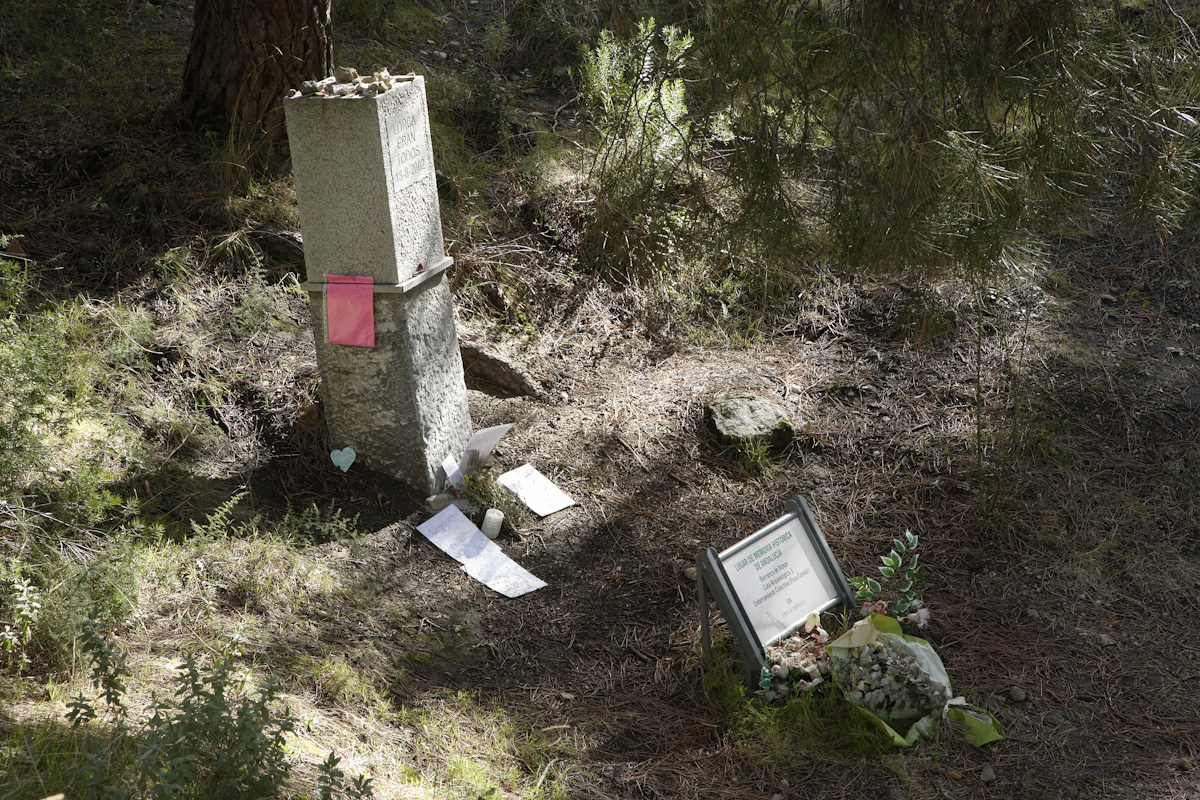
The Ravine, along with the walls of the cemetery of Granada, was the place where more left-wing sympathizers were shot. The shootings in Víznar reached Puerto Lobo, where there is evidence of the existence of several graves, although archaeologists have not found human remains in them.
The repression, according to historians, followed a premeditated plan of systematic elimination of the Republican political and union forces. After the first uncontrolled assassinations in August 1936, the repression was organized and focused on the leaders and participants in the strikes during the Republican period. The executions in Víznar did not end with the war and continued years later.
August 19 hosts a poetry evening, which began to be held clandestinely during the last years of the dictatorship, which begins at midnight and lasts until the early hours of the morning.
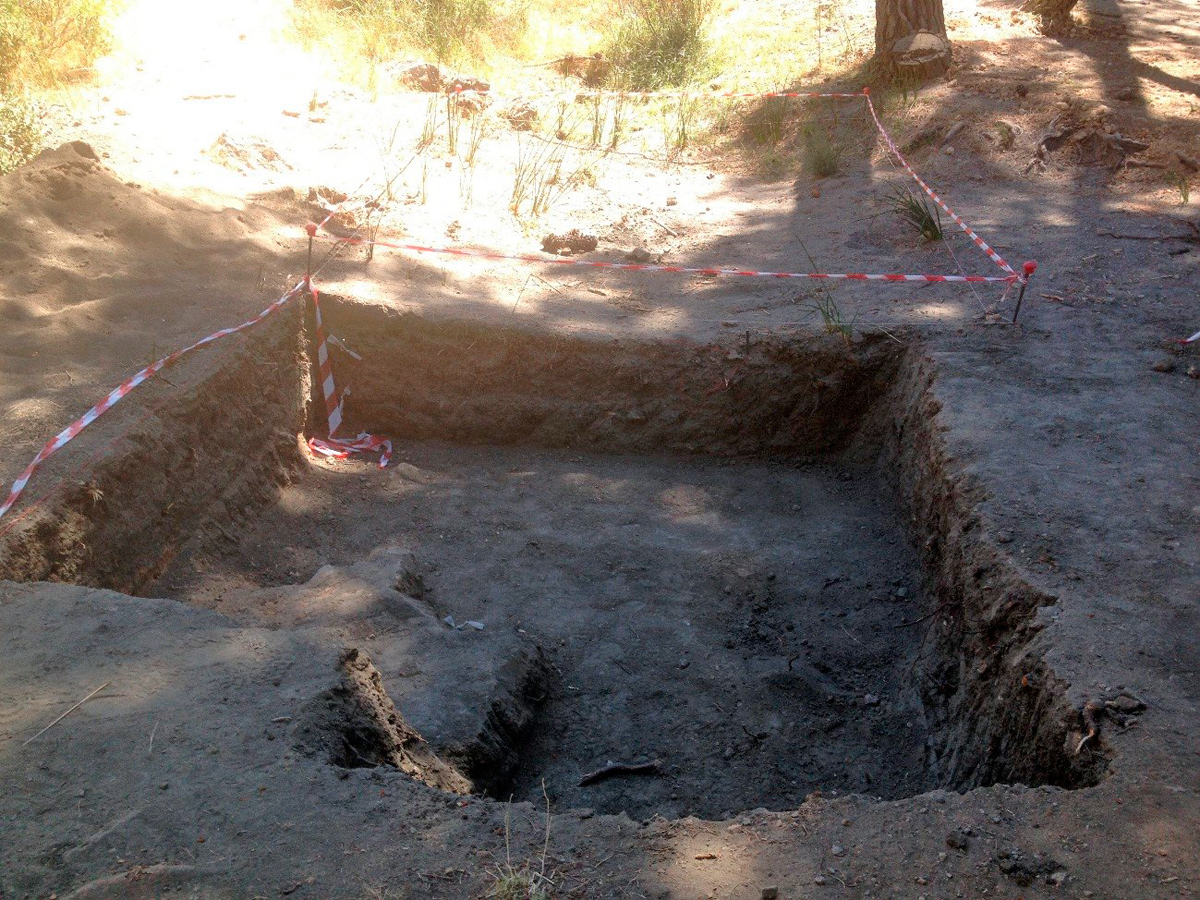
On June 28, 2013, the City Council of Víznar and the General Directorate of Democratic Memory began a series of archaeological surveys to locate, mark and dignify the common burials of the Ravine. A total of eleven possible graves were dug up. The archaeologists found ammunition and human remains in five of them. The findings, however, were not publicly quantified. The Board filed a complaint for crimes against humanity so that the judge would take notice and, if he deemed it appropriate, investigate what it called “a sample of violence generated by a public power in a systematic way”.
Subsequently, in 2014, the search for graves was extended to another 40,000 square meters in the area of Puerto Lobo where archaeologists found no human remains.
The French Hispanist Claude Couffon is the only investigator who maintained, until his death in 2013, that Federico García Lorca was murdered and buried in the Barranco de Víznar. Couffon was one of the first investigators to overcome the fear of reprisals of the new regime and climb the Barranco de Víznar in search of evidence of the murders. It was in 1948. “When I was 22 years old, I was quite daring. Nobody wanted to talk in Granada about what had happened. It was dangerous to ask questions and it was impossible to enter Víznar,” he recalled on his last visit to Granada in 2011.
Couffon returned to Granada in 1949 and established new contacts to continue his investigation. “I had access to the right people. For me the investigation was closed. Once I published my first conclusions, hundreds of speculations began to be made. Everyone wrote a different version. There were many myths and many lies.”
Despite the testimonial evidence provided by other investigators, Couffon always defended that Lorca was in the Ravine. “At first the graves were shallow. I could see them, and even touch them. There were about 20. Federico was not in the central pit. He was in a smaller one, possibly in that area. It was easy to recognize them. It was a steep place, all rock, with no trees. Today it’s full of pine trees. Hasn’t anyone thought about that?”
After Couffon in 1948 other investigators, all foreigners, went into the Ravine in search of evidence of the shootings. In 1949, Gerald Brenan, accompanied by his companion Gamel Woolsey, decided to look for Frederico’s grave. He wrote the details of the visit in the book The Face of Spain. Brenan and his companion were helped by an old woman who suggested that the body was not in the cemetery but in the ditches of the Ravine.
In 1960, the novelist Marguerite Yourcenar and her friend Grace Jones visited Víznar, following Lorca’s footsteps. Thanks to two boys from the village who offered to act as guides, they toured the places where the poet was supposedly buried. “If it is the authentic site that they had shown us, it is evident that the murderers made a circuit, completed their crime and erased the tracks in that wasteland before returning to the village by another road with more traffic,” she wrote.
The French Hispanist Marcelle Auclair, personal friend of Lorca and Ignacio Sánchez Mejías, specialist in Santa Teresa, visited Víznar in 1964 where she located the place of death described by Brenan and Couffon. Auclair climbed alone to the Ravine and in 1966 returned accompanied by a very young Ian Gibson who followed the same track. Both investigators shared data that are reflected in the books they published in 1968 (Auclair) and 1971 (Gibson).
Ian Gibson arrived in Granada with his wife in 1965 with the idea of spending a year investigating the death of the poet. The initial contacts were not easy. “Thanks to a small number of friends who had known Lorca intimately, I found a growing number of natives from Granada who had spent the first months of the rebellion in their hometown and were able to give me detailed and verifiable information about the period.” Gibson is the most important biographer of García Lorca to whom he has devoted dozens of books.
The most controversial investigation among the foreigners who went up to Víznar and Alfacar was that of Jean-Lous Schonberg. If on the one hand he was the first to highlight the influence that Lorca’s homosexuality had on the hatred raised among the Granada right wing in 1936, on the other he invented that the poet had been killed in a fight between homosexuals.
The leak in August 2016 of a Francoist Police report dated 1965 brought back the controversy over the burial place of García Lorca to the forefront. Although the report is riddled with questionable statements, as if it were the product of a hasty investigation to comply with some formal bureaucratic requirement, the Regime’s police specify that the grave where the poet was buried is located “about two kilometers to the right” of Aynadamar or the Fountain of Tears, “very deep in the ground, in a ravine, a place that becomes very difficult to locate.” The description contained in the report gave rise to the idea that Lorca was in the Barranco de Víznar. The same document accuses Lorca of supposedly belonging to the Alhambra Masonic Secret Society and accuses them of “homosexual practices, an aberration that became vox populi”.
In early summer 2015, the City Council of Víznar placed a plaque in the main grave of the Barranco de Víznar in which it assures that García Lorca and his companions in the shooting were buried in the grave “2 C” of the five identified, two years earlier, in the surveys of the General Directorate of Democratic Memory.
According to the official report of the archaeologists of 2013, “superimposed skeletal remains of three individuals, in a collective burial of less length than in the adjoining area, specifically with dimensions of 3.00 meters long by 0.50 meters wide by 0.86 meters high”, were identified in grave 2 C.
For the archaeologists, the “most striking” characteristic of this burial was the reduced occupation of the compartment, the compression of the skeletal remains and its location within the perimeter of zone 2 “but outside the northern profile”.
The plaque was mysteriously removed in August 2015 after the archaeologist who directed the excavations declared that there was no evidence that Lorca, the two “banderilleros” and the master of Pulianas had been buried there.
Cuando se hundieron las formas puras
[When the pure forms sank]
bajo el cri cri de las margaritas,
[in the cri-cri of daisies,]
comprendí que me habían asesinado.
[I knew they had assassinated me.]
Recorrieron los cafés y los cementerios y las iglesias,
[They combed the cafes, cemeteries and churches,]
abrieron los toneles y los armarios,
[they opened the wine-casks and cupboards,]
destrozaron tres esqueletos para arrancar sus dientes de oro.
[destroyed three skeletons to take their gold teeth.]
Ya no me encontraron.
[But they couldn’t find me.]
¿No me encontraron?
[They didn’t find me?]
No. No me encontraron.
[No. They didn’t find me.]
Pero se supo que la sexta luna huyó torrente arriba,
[But it was known the sixth moon fled above the torrent,]
y que el mar recordó ¡de pronto!
[and the sea— suddenly!— remembered]
los nombres de todos sus ahogados.
[the names of all it had drowned.]
- Miguel Caballero. The thirteen last hours in the life of García Lorca. La Esfera de los Libros. Madrid, 2011.
- Ian Gibson. From New York to Fuente Grande. Grijalbo. Barcelona, 1987.
- Ian Gibson. Life, Passion and Death of Federico García Lorca. Debolsillo. Madrid, 2016
- Federico Molina Fajardo. García Lorca and Víznar. Memoirs of General Nestares. Ultramarina. Granada, 2012.
- Eduardo Molina Fajardo. The last days of García Lorca. Plaza y Janés. Barcelona, 1973.
- Agustín Penón. Fear, Forgetfulness and Fantasy. Marta Osorio Edition. Comares. Granada, 2000.
- Antonio Ramos Espejo. García Lorca in Fuente Vaqueros. FGL Birthplace Museum in Fuente Vaqueros. Granada, 2008.
- Fernando Valverde. Return to the ravine of death. El País, 15 June 2011.
- Lorca´s location
- Víznar Ravine
- current location
- Víznar Ravine
- ADDRESS
- Carretera de Víznar a Alfacar (GR-3101)
- DETAILS OF THE VISIT
Public place of free access recognized as a Place of Memory.
